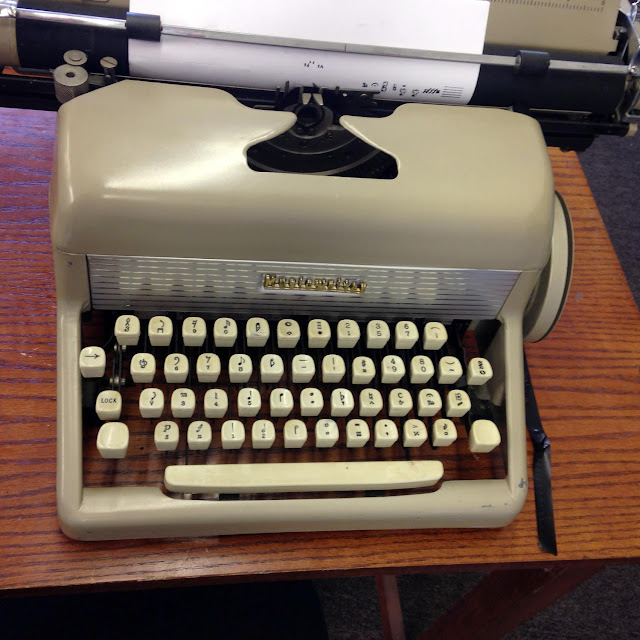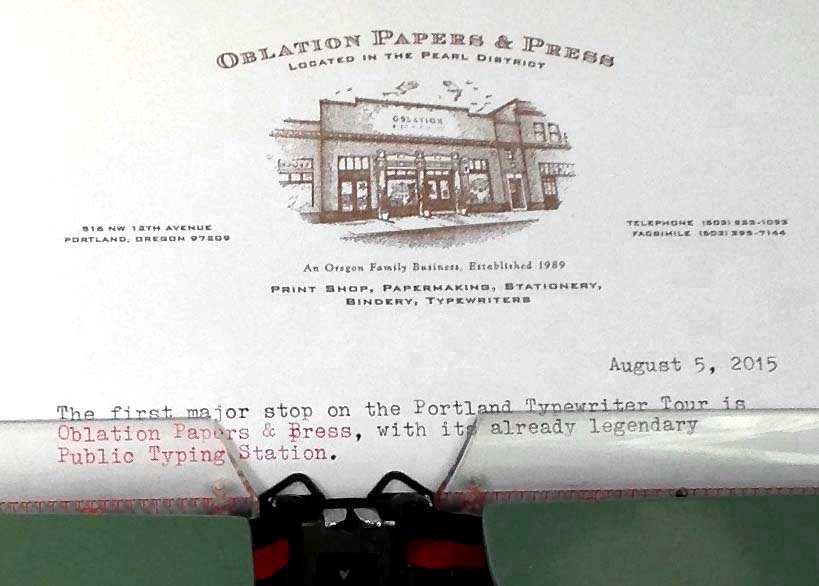Richard Polt has been pursuing his love of the typewriter for more than 20 years as a collector, webmaster (The Classic Typewriter Page), blogger, magazine editor (ETCetera), repairman and frequent typist. In The Typewriter Revolution: A Typist’s Companion for the 21st Century (Countryman Press, November 2015) he explores creative uses of typewriters today — including unexpected intersections between typewriters and art, music, politics and the digital world. The book also advises readers on choosing, using, modding (modifying) and maintaining a writing machine of their own. When he is not spearheading the typewritten revolution, Polt teaches philosophy at Xavier University in Cincinnati.
What was your first experience with a typewriter?
I remember my father writing academic papers on his electric Smith-Corona, and my mother using a large-type Woodstock to prepare dittos. I always felt the machines were magic. Like musical instruments, they’re finite devices with infinite potential. That feeling has never disappeared.
What was the first typewriter you owned, and how many do you own today?
My father bought me a 1937 Remington Noiseless Portable #7 when I was about 12, and it’s still my sentimental favorite. After 20 years of collecting, I have some 300 typewriters, ranging from an 1875 Sholes & Glidden to a Royal portable made in China just a couple of years ago. There are so many designs that collecting typewriters is an inexhaustible hobby.
Using a typewriter is such a visceral joy. How do you compare it to using a digital keyboard?
You said it! A keyboard is a comfortable, quick tool for making text, but sometimes the journey is the destination: you want to experience the act of writing as a pleasure in itself. Then it can be great fun to feel the springy snap of typewriter keys, hear the tapping and the bell, sense the heft of the carriage as you return it, and admire the look of a well-designed machine. There’s even an alluring aroma of ink and oil.
Typewriters have largely been replaced by computers. Are they experiencing a resurgence for nostalgia’s sake or other reasons?
There’s a touch of nostalgia for a middle-aged guy like me, but there’s so much more. Teens are excited by their first typewriters. Artists and activists are inviting people to type thoughts that have never been expressed before. Makers are experimenting with typewriter-computer interfaces. And as the digitization of the world races forward — challenging our privacy, our powers of concentration and our self-reliance — it becomes ever more important to find ways to stay connected to physical reality. That’s why I call the typewriter revival an insurgency against the all-digital paradigm. As I say in my book, “Our movement isn’t nostalgic, much as we love our objects from a bygone world. We insurgents are pointing a way forward to greater focus, creativity and independence. Typewriters are one way to keep the digital in perspective and keep ourselves free.”
Is it hard to find ribbons and parts for a typewriter, or find someone who still repairs them?
You’d be surprised how many typewriter mechanics are still doing business, either in shops or from their homes. Thanks to online sources and groups, it isn’t hard to find parts unless you have a really uncommon model. And ribbons are readily available. I maintain a list of repair shops on The Classic Typewriter Page and list some ribbon sources in my FAQ.
Tell us about events like New York City’s Typewriter Project and Type-Ins to get people to go analog.
Typewriters can help individuals get back in touch with themselves, but they can also create deeper connections with others. The machines become the occasion for collaborative creation as in the Typewriter Project, or for spontaneous encounters more satisfying than the typical online experience. You find typewriters at social events such as digital detox parties, snail mail socials and type-ins, where people and their machines get together for typing, chatting and fun. I’ve organized and attended a few type-ins and had a great time.
How big is the typosphere’s fan base, and is it global?
The typosphere in the narrow sense is a set of blogs that discuss typewriters and may even be typewritten. There are about 100 of them, mostly based in the English-speaking world but some in German. In the broader sense, the online typewriter world includes a lot more, such as hundreds of writers who post typewritten poems on Instagram, or a Facebook page where a Pakistani typist shares with over 70,000 followers. I’ve seen a surge in typewriter love in Turkey, India and Singapore. And what you see online is just the tip of the iceberg.

























































































































































